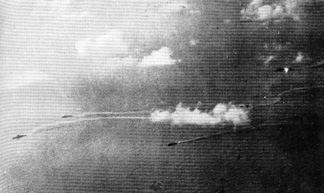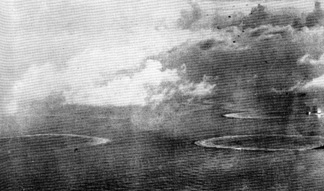|
U.S. Naval Aviation In the South Pacific during WW II Featuring the Lexington Aircraft Carrier The Battle of the Marianas — June 1944 Chapter 3 Page 3 of 7 Pages |
|||||||||
| Thirty four planes were to be launched from the Lexington in the first strike; 11 fighters, 16 dive bombers and 7 torpedo bombers. The fighters were launched first. They were always first off because they need less deck to get airborne). The Avengers were next to be launched. I was the first Avenger to leave the deck only because the plane I had been assigned happened to be spotted in that position. The dive bombers were the last to launch. Bill Linn's Avenger had a problem develop going down the deck on takeoff when his propeller slipped from full low pitch to medium high pitch. It was too late for him to do anything but keep on going and hope he would be able to get into the air. He had lost half his oil before clearing the deck but he was able to get her airborne but obviously could not continue on the strike. He flew clear of the TF screen of ships and jettisoned his bombs in an unarmed condition and would hopefully make it to another carrier before his engine would fail. |
|||||||||
| The remaining six Avengers flew in sections of three each. Our leader was Lt. Norman Sterrie who until a few days earlier had been the squadron's Executive Officer. Our skipper, Lt. Commander Robert Isely had been shot down over Aslito Airfield on Saipan. Sterrie became the captain of the squadron on the day that Isely was killed.
Each strike force from each carrier involved in this event operated independently from the others. However, everyone had been ordered to go for the enemy carriers first and we all had been given the same information regarding the position, direction and speed of the enemy fleet. |
|||||||||
|
You have heard of the Lexington |
|||||||||
| The launches from all of the carriers had been made at approximately the same time. The result was that as we came closer to the target area planes from other carriers were visible and it was a good warm feeling to realize we were going to have lots of company on the attack.
We all knew that we had to be careful about fuel consumption. We also knew that if we did not make a certain ground speed we would arrive over our target in near darkness. Things were progressing pretty well when a scout plane gave an update on the position of the enemy fleet. This new location placed the enemy fleet approximately 60 miles further away than first anticipated. This was an additional concern for the dive bombers and torpedo planes. The initial position that had been given made the issue of range a little "iffy." These added miles to the target compounded the concern. |
|||||||||
| At 6:45 pm visual contact with the enemy fleet was made. The ships appeared to be in three groups. The main group consisted of two large carriers, two battleships, two or three heavy cruisers, four or five light cruisers and destroyers. It was this group that was selected by our leader for the attack.
We were at about 9500 feet and still a few miles from pushover to the target when we came under attack from enemy fighter planes. [Click here for a view of the Attack Map layout with a quick return to this page.] We were now flying in very close formation and in alignment that allowed our turret gunners to give maximum firing power against the attacking planes. At this point the radioman becomes a gunner and mans a 30 caliber machine gun that protrudes out of the stern of the tunnel of the Avenger and that has a capability of covering a 40 degree angle right and left and down from the tail of the plane. Things were popping and cracking pretty good for awhile. |
|||||||||
 |
|||||||||
|
Below: Heavy cruiser (right) completes frantic circle to escape planes. Flashes above cruiser are bomb hits on carrier and battleship narrowly averting collision. |
|||||||||
 |
|||||||||
| My crew counted four Zeros on our tail at one stage of this melee. Some kind of miracle occurred however as only one of our six planes was shot down. Mac McLellan and both his crewmen were able to abandon the plane as it was burning and parachute down to what turned out to be smack dab in the middle of the show. Chapter 3— End of Page 3 of 7 Pages — Go to Page 4 Page —1 — 2 — 3 — 4 — 5 — 6 — 7 Or This Story’s Cover Page — Editor’s Introduction — Table of Contents Fred Gwynn’s “Torpedo 16” — Chapter — 1 — 2 — 3 — 4 Or Home - Contact Us - Cold War Hist. - 91st SRS Hist. - Stardust 40 Mission Story |
|||||||||